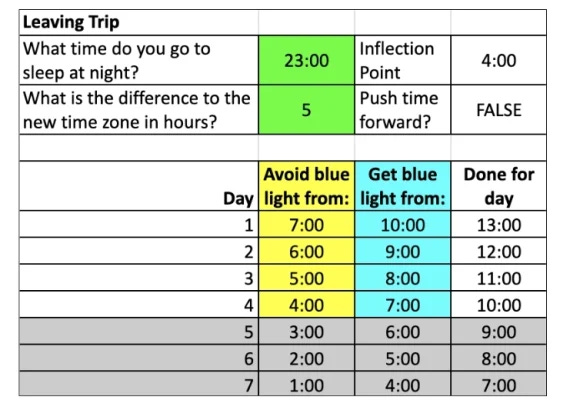Jet Lag Hacked
Utilizing Circadian Rhythms and Blue Light for Seamless Time Zone Transitions
We've talked about how much sleep is best for you, but what about when your sleep schedule is off? As global travel rebounds in the post-COVID era, many of us are again facing jet lag challenges. But what if we told you there's a scientific way to manage it? Let's learn about circadian rhythms and how understanding them can help you conquer jet lag.
Understanding Circadian Rhythms
Our bodies operate on a natural 24-hour cycle known as the circadian rhythm (CR). This internal clock regulates physiological processes, including sleep-wake cycles, hormone production, and digestion. When we're off our circadian rhythm, we often feel tired, and our bodies don't function optimally - even our digestion can be affected.
The Blue Light Effect
The key to manipulating our circadian rhythm lies in our exposure to blue light. Our bodies are particularly sensitive to blue light during two crucial three-hour windows each day:
1. The first three-hour window occurs from first to the fourth hour after your usual bedtime. Exposure to blue light during this time will shift your CR later.
2. The second three-hour window is the fourth to seventh hour after your usual bedtime. Blue light exposure during this period will shift your CR earlier.
The closer you are to the "inflection point" (about four hours after bedtime), the stronger the effect of blue light exposure.
Strategies for Shifting Your Circadian Rhythm
I used to try to adjust my sleep schedule before traveling, but staying up four hours past my bedtime and sleeping in four hours put me badly out of sync with the rest of the world, and getting blue light sources in the middle of the night was a challenge. Using the sunlight available at the right time at your destination is easier.
For Westward Travel:
You can shift your CR up to two hours later each day. Expose yourself to blue light from one hour after your normal bedtime to four hours later. Each day, move this exposure period two hours later until you're aligned with the local time.
For Eastward Travel:
You can shift your CR about one hour earlier per day. Get blue light exposure from four to seven hours after your usual bedtime. Move this exposure period one hour earlier each day until you're in sync with the local time.
The Red-Eye Flight Conundrum
Red-eye flights, typically eastbound overnight flights, are notoriously disruptive to our circadian rhythms. They often involve late-night exposure to blue light from airport lighting and electronic devices, pushing our CR later when we need to shift it earlier. Upon arrival, morning sunlight can further complicate the adjustment, resulting in a slow, daily drag of our sleep cycle across the middle of the day.
So, let's see how you could manage your jet lag on a winter flight from New York to London. In winter, London is five time zones ahead of New York. Since that's eastward travel, you'd want morning light exposure to shift your CR earlier. Of course, the first step is NOT to get light exposure if leaving on a late-night plane, which would move your CR in the wrong direction. Wear orange glasses or shades (like a rock star) until you can get on the plane to sleep.
Once you've arrived in London, you'll want to avoid blue light from 7 AM until 10 AM to avoid delaying your CR. Then, from 10 AM to 1 PM, go outside, even if cloudy, and get daylight or find blue light inside. Since you're moving your CR earlier, you can only adjust it an hour daily, so move those windows an hour earlier each day until your CR is close enough to local time.
Practical Tips for Managing Blue Light
To Get Blue Light:
Natural sunlight is best
SAD (Seasonal Affective Disorder) or blue spectrum lights also work
Computer screens without night mode activated
To Avoid Blue Light:
Wear orange-tinted blue-blocking glasses or sunglasses (Amazon search - Not an affiliate link)
Stay indoors
Use night mode on electronic devices
Sleep Approach
Try to sleep at your normal bedtime in the new time zone. Don't worry too much about naps or variations in sleep times, as sleep itself doesn't shift the CR. Melatonin supplements (5mg is plenty) can help induce sleep when your body clock is off. These are available over the counter in the US and many European countries or by prescription elsewhere.
A Handy Tool
For those who want a precise guide, I've made a simple calculator that shows when you should seek or avoid blue light based on your bedtime and the time zone shift. You can find and duplicate this sheet to personalize it for your travel needs.
Conclusion
By understanding and manipulating your circadian rhythm through strategic blue light exposure, you can significantly reduce the impact of jet lag. Remember, the key is having a plan for your arrival being mindful of your light exposure when you arrive. With these tools, you're well-equipped to make your next cross-time zone journey a smoother, more enjoyable experience.
Safe travels, and may your circadian rhythm always be in sync!
Ready to Hack Your Lifestyle and Live Longer? Subscribe Now and start your journey to a longer, healthier life!
Discover your true biological age with our FREE Longevity Calculator and unlock personalized biohacks to optimize your health and well-being.




